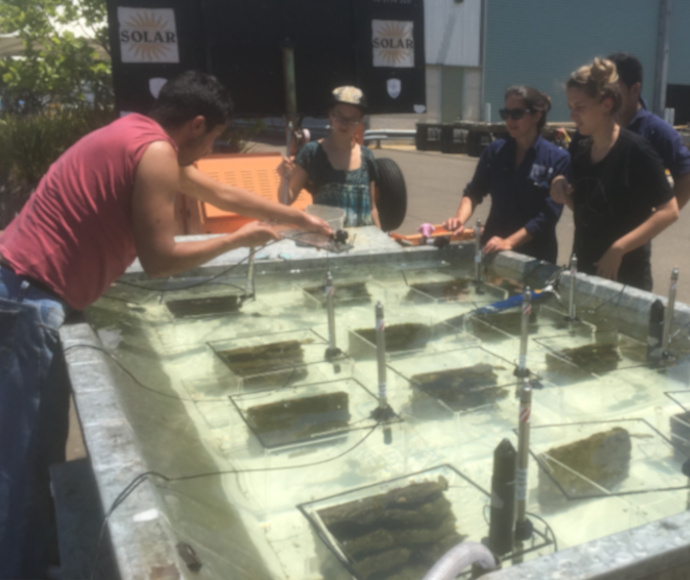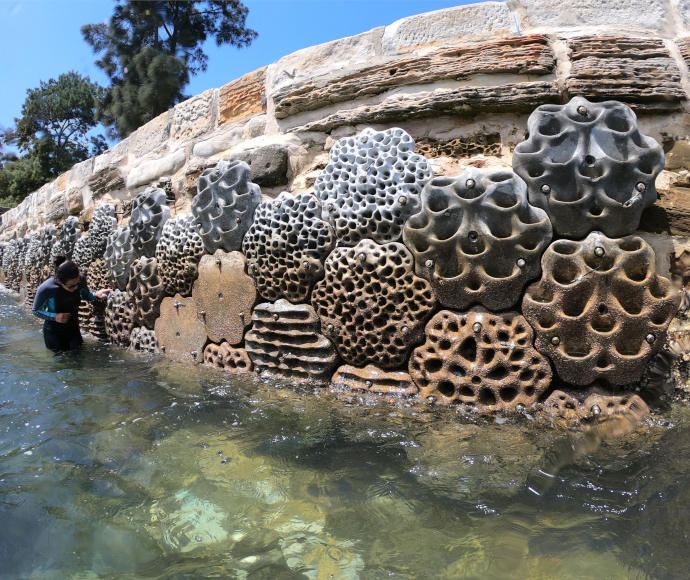Measuring what matters in healthy marine environments
Physical complexity, species diversity, ecosystem functioning: there’s a lot to untangle when it comes to finding the best ways to protect and restore our marine habitats.
Human-built structures such as seawalls, jetties, pontoons and marinas have a range of purposes, such as protecting shorelines or creating organised spaces for boating activities. These structures have traditionally been flat and featureless, with none of the rocky hollows and crevices that marine creatures seek out to build a home or hide from predators.
Restoring natural variations in artificial walls
The Living Seawalls project, a flagship project of the Sydney Institute of Marine Science, seeks to improve how we build structures to support healthier marine ecosystems. They’ve developed habitat enhancement panels with plenty of nooks and crannies that can be attached to flat surfaces in marine environments to add variation and physical complexity.
The panels help mimic the natural rocky foreshore environment, making these spaces more appealing for marine life and boosting local biodiversity. Yet scientists weren’t sure how increasing the habitat complexity of these built structures might impact other functions in the marine ecosystem, like oxygen production or nutrient uptake rates.
Dr Jaimie Potts, a senior environmental scientist with the Department of Planning and Environment, said these ecological processes have been studied before in estuarine environments. However, the effects of physical and biological complexity on those processes haven’t been studied in rocky shores or artificial habitats in context to physical and biological complexity: 'No one has done that work before.'
What makes marine habitats healthy and productive?
The department collaborated with scientists from the University of New South Wales (UNSW), including 2 of the co-leaders of the Living Seawalls project, the Department of Primary Industries, and other Australian and international universities to study how habitat complexity, biodiversity and ecosystem functions interact in built infrastructure.
The study’s lead author, Dr Mariana Mayer Pinto, is a marine ecologist with UNSW and co-founder of the Living Seawalls project. She often works directly with managers of marine environments and geoengineers who design marine structures, and knows that they need to understand the ecosystem services of that environment.
'They want to know about water quality and fishing productivity – but to understand that, we need to start measuring some of the functions that underpin those services,' she said.
The team tested 2 different habitat types in a marine setting by comparing smooth, flat tiles with more complex, ridged tiles that were 'more conducive' to encouraging marine creatures to settle.
They added oysters into these environments due to their 'ubiquitous presence' in typical intertidal marine environments, and also because the oysters themselves helped make the tiles even more complex: 'they grow rapidly and become a hard structural feature attached to that surface,' said Dr Potts.
Don’t count your oysters…

After spending 'a lot of nights' taking measurements, the team confirmed that increasing physical complexity in a habitat (having varied, bumpy surfaces instead of smooth, flat surfaces) encouraged more biodiversity. 'If you increase complexity, either by seeding [with oysters] or by changing the physical substrata, you get more diversity,' said Dr Mayer Pinto.
But some of their findings were unexpected. They found that increased biodiversity doesn’t always translate to better ecosystem functioning or productivity. Factors such as surface structure or the amount of sunlight an area receives can have an impact on how marine creatures function.
'It’s not enough to count or measure the number of oysters: you need to measure what they’re doing,' said Dr Mayer Pinto. 'Or it’s not enough to see how much macroalgae is there, you also need to measure how much oxygen they are producing in terms of photosynthesis.'
The findings have important implications for how marine structures and sites are designed, depending on what kinds of ecosystem services are most important. If excellent water quality is the goal, for example, you want an environment that encourages plenty of filter-feeding animals like oysters and mussels, but you also want to make sure they’re living their best and most productive lives.
'It’s really not a one size fits all solution,' said Dr Mayer Pinto. 'You need to be a bit careful in terms of the design.'
The results have been published in the Journal of Applied Ecology.
